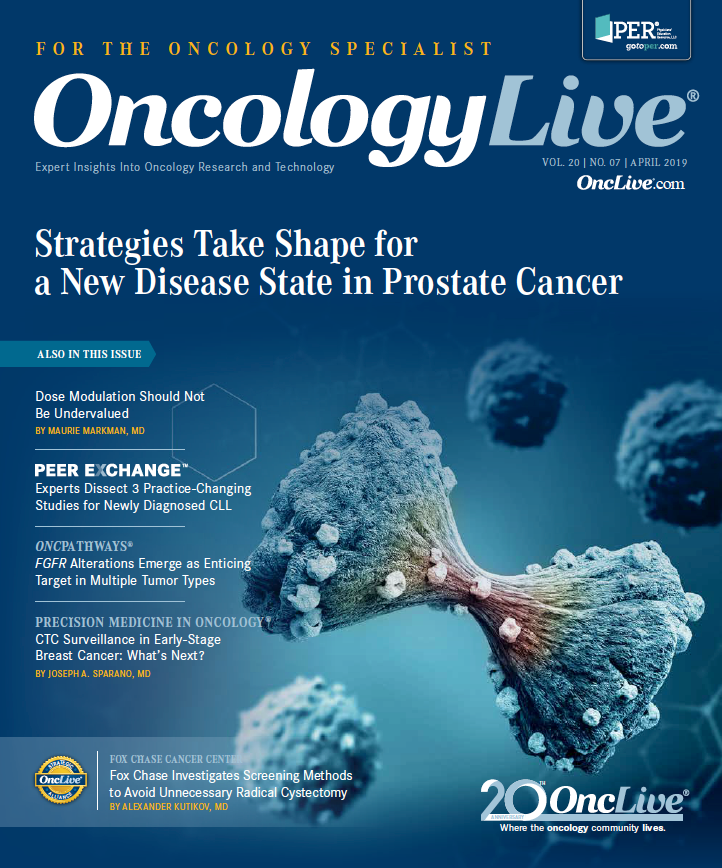Publication
Article
Fox Chase Investigates Screening Methods to Avoid Unnecessary Radical Cystectomy
Author(s):
Currently, there is no reliable way to identify who can safely avoid radical cystectomy following MIBC treatment. For this reason, Fox Chase Cancer Center researchers are trying to find the as-yet-elusive 30% by asking 3 important questions.

Alexander Kutikov, MD
Chief of the Division of Urology and Urologic Oncology
Fox Chase Cancer Center
Philadelphia, Pennsylvania
Although the standard of care for muscle invasive bladder cancer (MIBC) is to remove the entire bladder, in some 30% of resections the organ is found to not harbor residual cancer, especially after neoadjuvant chemotherapy.
Advising patients that they should have life-changing surgery is a difficult task many urologic oncologists face. When no residual cancer is found after the removed bladder is biopsied, the question naturally arises, ”How can we improve our assessments to make better decisions with respect to radical cystectomy versus bladder-sparing treatment?”
Currently, there is no reliable way to identify who can safely avoid radical cystectomy following MIBC treatment. For this reason, Fox Chase Cancer Center researchers are trying to find the as-yet-elusive 30% by asking 3 important questions:
- How often does cystoscopy miss MIBC after treatment, and why?
- Can mutations in the tumors or other biomarkers generated by the tumors predict whose cancers will or won’t respond favorably to chemotherapy?
- What combination of factors can be used to develop a better assessment process for retaining the bladder when it is safe to do so and thus spare patients from this high-risk, life-changing surgery?
Weighing the Value of Cystoscopic Inspections
Because Fox Chase focuses on clinical research as well as treatment, our team wanted to find a way to safely identify patients by risk level. In an initial, retrospective study, we are evaluating patients who had a standard-of-care (SOC) cystectomy to see what factors reliably predict when bladder removal is not necessary because the cancer has been cured by treatment. In a second, prospective study, we are following the progress of patients exempted from cystectomy whose cancers show genetic signatures that correspond to a high rate of cure following chemotherapy.In the first study, we are recruiting patients who are scheduled to have a cystectomy, as per SOC (Figure 1).1 On the day of the cystectomy, a standard rigid cystourethroscopy is performed and urine and plasma samples are collected, ≤2 tumor sites are targeted for sampling, and a novel scoring system is used to objectively quantify endoscopic findings and index the presence of papillary tumor, erythema, and scar. Additional biopsies are taken for assessments of genomic signatures.
Figure 1. Value of Cystoscopic Evaluation Prior to Radical Cystectomy1 N = 80
The goal is to identify ways to improve diagnostic evaluation for future patients. We have enrolled patients at the lowest risk for harboring residual carcinoma after undergoing endoscopic treatments and/or chemotherapy. The primary outcome measure is accuracy of endoscopic assessment in predicting pT0 urothelial disease in the bladder at the time of radical cystectomy. Secondary measures include determination of whether genomic tumor signatures from pretreatment tumor tissue can predict chemotherapy response. We are developing standardized descriptions of the tumor cystoscopic findings through the novel mapping and scoring system. By comparing the precystectomy observations with the postcystectomy pathology, we can determine how well urothelial carcinoma of the bladder can be detected through rigid cystourethroscopy.
Urologic surgeons know that, in some cases, tumors are not visible on the bladder wall surface because the top layers have been cut off during previous cystoscopies, making the submucosal layers no longer visible. When cancer cells are present in tissue specimens after cystectomy, our mapping system shows where they are, what kind they are, and what can or cannot be seen during a cystoscopy, which will help physicians better determine if cancer has been missed.
Correlating Genetic Mutations With Treatment Response
Figure 2. Risk-Enabled Therapy After Neoadjuvant Chemotherapy (Retain Bladder)2
A Risk-Assessment Approach Toward Cystectomy
This is a step toward better identification of which patients with MIBC need a radical cystectomy. The trial also marks the first time the true negative predictive value of a normal cystoscopic evaluation is being quantified, allowing us to establish how often bladder cancer hides under the mucosa and evades endoscopic diagnosis.In the study described above, we obtained tissue and urine samples to better understand the impact that a muscleinvasive tumor’s genetics and location have on its response to chemotherapy. We are also using detailed precystectomy cystoscopic findings and postsurgery analysis of tissue and urine samples to better understand how and why cystoscopy misses some cancers. At Fox Chase, Phillip Abbosh, MD, PhD, and other investigators in his lab have identified a unique biomarker released into the urine by bladder cancers. The results so far indicate there is an inverse relationship between the presence of this biomarker and effective chemotherapy treatment. As Abbosh explains it, “The presence or absence of the urinary biomarker after chemotherapy seems to correlate with the pathological stage of the cystectomy specimen, and this could be used to score the risk of residual bladder cancer. Our study is validating the test’s prognostic ability.”The second MIBC-related study at Fox Chase, RETAIN BLADDER, is investigating whether patients who have specific tumor genetic mutations will respond favorably to treatment (Figure 2).2 Next-generation sequencing is used to identify patients positive for ATM, RB1, FANCC, and ERCC2 mutations. They are then treated with neoadjuvant accelerated methotrexate, vinblastine, doxorubicin (Adriamycin), and cisplatin (AMVAC), biopsied for residual tumor, and then placed on active surveillance or given further treatment and potentially cystectomy. The primary endpoint is metastasis- free survival at 2 years. Secondary endpoints include assessing the rate of urothelial carcinoma recurrence in active surveillance patients and assessing bladder preservation rates with neoadjuvant AMVAC.
Led by Fox Chase’s Daniel M. Geynisman, MD, the study’s risk-adapted approach identifies genetic mutations in the cancer cells to predict whether chemotherapy will be effective in preventing recurrence or metastases for at least 2 years. “If we can develop predictive biomarkers to figure out who responds to chemotherapy and who doesn’t, we can [make treatment] recommendations in a more nuanced way,” Geynisman said.
Abbosh is the genetic researcher in this study, as well, and is examining different tumor-generated biomarkers present in the urine to evaluate response to chemotherapy treatment for those with bladder cancer.
Forming Risk-Based Recommendations
“We also know, through well-established research, that cancers with specific genetic mutations won’t respond well to chemotherapy, indicating that the patients should have the [SOC] radical cystectomy. This biomarker test adds a riskoriented perspective to the discussion of how to proceed after MIBC treatment,” Geynisman said.We hope the 2 studies will give new perspectives on effective bladder cancer treatment and traditional SOC recommendations. By combining clinical data with molecular or genomic data and taking a risk-balanced approach based on different genetic markers in MIBC, our goal is to enable doctors to make smarter decisions with their patients about cystectomies and, where possible, spare them from the life-changing procedure. Both studies are still open for enrollment.
For the cystoscopy/cystectomy study, eligibility includes, but is not limited to, as follows:
- Men or women older than 18 years at the time of consent
- Patients with a diagnosis of MIBC urothelial carcinoma clinical stage T1-T4NanyM0
- Patients with a clinical decision to proceed with radical cystectomy by any conventional approach (open, laparoscopic, or robot-assisted laparoscopic)
The trial excludes patients who undergo cystectomy with noncurative intent or patients who have undergone any prior pelvic radiation.
For the RETAIN BLADDER study, eligibility includes as follows:
- Primary urothelial or predominantly urothelial carcinoma of the bladder
- AJCC clinical stage T2—T3 N0M0 disease
- ECOG performance status of 0-1
- Left ventricular ejection fraction ≥50%
- Adequate organ (creatinine clearance ≥50 mL/min) and bone marrow function
This trial excludes patients who have any component of smallcell histology, prior pelvic radiation, prior systemic therapy or radiation therapy for urothelial carcinoma, and/or hydronephrosis that has not been adequately addressed or assessed.
References
- Assessment of Reliability of Cystoscopic Evaluation Predicting pT0 Urothelial Carcinoma of the Bladder at the Time of Radical Cystectomy. https://clinicaltrials.gov/ct2/show/NCT02968732?term=Assessment+of+Reliability+of+Cystoscopic+Evaluation+Predicting+pT0+Urothelial+Carcinoma&rank=1. Updated April 13, 2018. Accessed March 18, 2019.
- Geynisman DM, Abbosh P, Zibelman M, et al. A phase II trial of risk-adapted therapy after initiating neoadjuvant chemotherapy for bladder cancer (RETAIN BLADDER). Poster presented at: 2018 American Society of Clinical Oncology Annual Meeting; June 1-5, 2018; Chicago, IL. Abstract TPS537. carislifesciences.com/wp-content/uploads/2018/02/ASCO-GU-A-Phase-II-Trial-of-Risk-Enabled-Therapy-After-Initiating-Neoadjuvant-Chemotherapy-for-Bladder-Cancer-RETAIN-BLADDER.pdf.










